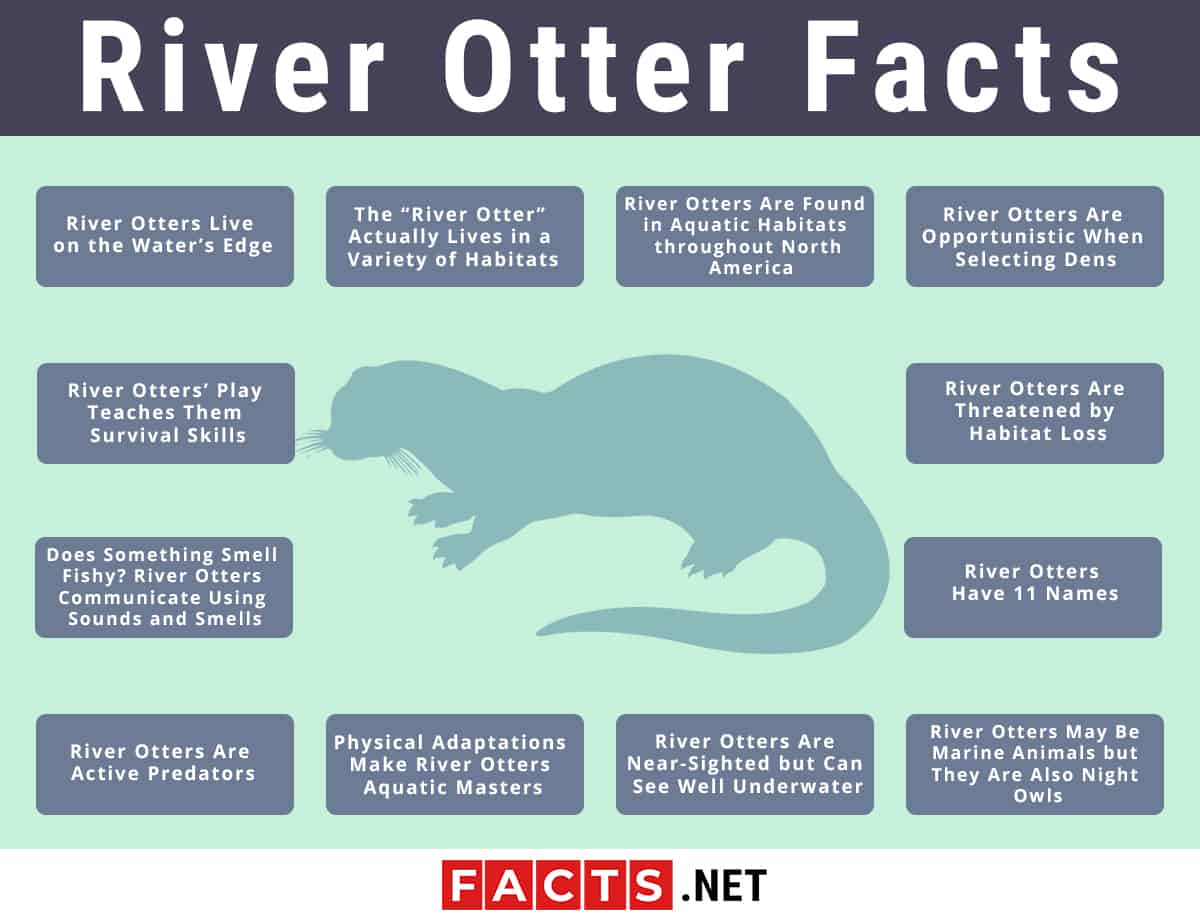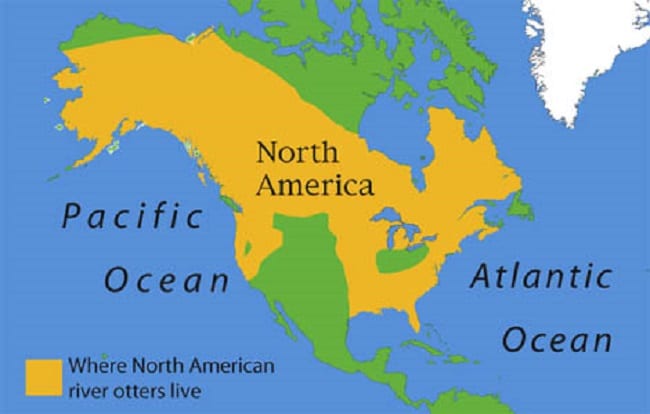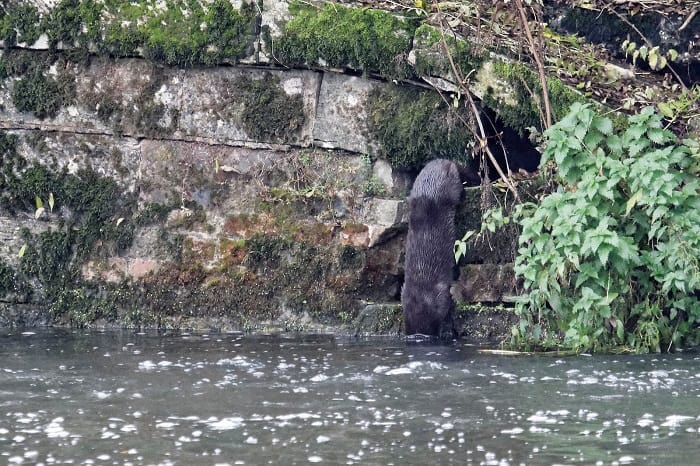
- Scientific Name: Lontra Canadensis
- Classification: Mammal
- Weight: 11 to 31 pounds (5 to 14 kilograms)
- Length: 26 to 42 inches (66 to 107 centimeters)
- Lifespan: 8 to 9 years (21 years in captivity)
- Aquatic Predators: Alligator, American crocodile, killer whales, sharks
- Terrestrial Predators: Coyote, bobcat, lynx, wolf, mountain lion, black bear, domestic dogs
- Human-related Mortality: Trapping, illegal shooting, road kill, accidental captures
- Conservation: Bioindicator in aquatic ecosystems
- Conservation Status: Least concern
- Location: River Otters Live on the Water’s Edge
- Name: The “River Otter” Actually Lives in a Variety of Habitats
- Habitat: River Otters Are Found in Aquatic Habitats throughout North America
- Homes: River Otters Are Opportunistic When Selecting Dens
- Diet: River Otters Are Active Predators
- Anatomy: Physical Adaptations Make River Otters Aquatic Masters
- River Otters Are Near-Sighted but Can See Well Underwater
- River Otters May Be Marine Animals but They Are Also Night Owls
- River Otters’ Play Teaches Them Survival Skills
- Does Something Smell Fishy? River Otters Communicate Using Sounds and Smells
- River Otters Are Threatened by Habitat Loss
- River Otters Have 11 Names
River Otter Facts Infographics

River Otters Live on the Water’s Edge

River otters are semi-aquatic mammals. They live in dens along the water’s edge. These dens, or burrows, can have several tunnel openings. There is always at least one tunnel opening that allows the otters to enter and exit the water.
The “River Otter” Actually Lives in a Variety of Habitats
It would be fair to assume that river otters are exclusively found on river banks. However, the name “river otter” is misleading. These creatures inhabit a wide range of aquatic habitats. These can include rivers, lakes, marshes, estuaries, inland wetlands and coastal shorelines. River otters can live in a variety of elevations and temperatures as long as they have easy access to water and a steady food supply. If an area is polluted, the river otter will move to a new place that isn’t tainted.
River Otters Are Found in Aquatic Habitats throughout North America

River otters have quite a large range. They inhabit both coastal regions and inland waterways. River otters can be found in Canada, the Pacific North West, the Atlantic States, and the Gulf of Mexico. Their range has actually decreased over the years due to urbanization and pollution.
River Otters Are Opportunistic When Selecting Dens

River otters live in dens, also known as holts. One of the most surprising river otter facts is that these otters don’t dig their own dens. River otters will either use a natural hollow or a burrow made by another animal. Examples of natural hollows include those in riverbanks, under logs, hollow trees and logs, rock formations, undercut banks, flood debris, and backwater sloughs. River otters have also been known to utilize the burrows made by red foxes, woodchucks, beavers, nutria, and muskrats. Although river otters generally prefer dens that provide seclusion and protection, they tend to be opportunistic when selecting a home. They will line the nest chamber with soft natural materials such as hair, leaves, moss, grass and bark.
River Otters Are Active Predators
River otters, like all otters, are carnivorous. River otters are predators; they avoid feeding on carrion. A river otter’s diet consists largely of fish. The species of fish will vary depending on the location and habitat. Crayfish are the second most common prey of river otters. In addition to fish and crayfish, river otters will feed on other readily available prey. They have been known to feed on mollusks, aquatic insects, amphibians, reptiles, birds and small mammals.
Physical Adaptations Make River Otters Aquatic Masters
River otters are particularly streamlined in water. One of the more surprising river otter facts is that this build hampers their agility on land. The characteristics that create the streamlined profile of a river otter include small ears, a neck that has the same diameter as the head, short powerful legs, webbed toes, and a tapered tail that constitutes one-third of the otter’s length.
River Otters Are Near-Sighted but Can See Well Underwater

Because river otters spend so much time in the water, and hunt for food in this environment, their eyesight is adapted for underwater vision. This means that river otters are actually near sighted. Their eyes are protected while they are swimming thanks to transparent nictitating membranes, which act like swimming goggles.
River Otters May Be Marine Animals but They Are Also Night Owls
One of the interesting river otter facts is that these creatures are generally nocturnal. This is particularly noticeable during spring, summer and autumn. During these seasons, river otters tend to be most active during crepuscular hours and at night. During winter when the climate is much colder river otters are more diurnal in their behavior, meaning they are more active during the day.
River Otters’ Play Teaches Them Survival Skills
River otters are known to be very playful creatures. They seem to prefer games such as wrestling and chasing. However, these games are not undertaken purely for enjoyment. River otters are able to learn vital survival skills through their play. These skills include hunting and fighting. When river otters are rubbing themselves and rolling around, they are simply drying their fur. This helps them to maintain the important insulation provided by their thick fur.
Does Something Smell Fishy? River Otters Communicate Using Sounds and Smells
One of the more intriguing river otter facts is that these animals largely communicate using auditory and olfactory signals. Intergroup communication generally occurs in the form of scent marking. There are various sounds that river otters make, depending on whether they are playing, irritated, in pain or in distress. River otters are most commonly heard emitting a low frequency chuckling. Other sounds include a hissing bark, snarling growl, shrill whistle, explosive snort, birdlike chirp and even low purring grunts.
River Otters Are Threatened by Habitat Loss
One of the most unfortunate river otter facts is that these animals are currently threatened by habitat loss. Their habitat has been suffering from a negative impact since North America was colonized by Europe. The river otter population continues to decline to this day. This is likely the result of environmental pollution, to which these otters are particularly sensitive. Several conservation projects have been started in an attempt to stabilize their numbers.
River Otters Have 11 Names
The river otter was first identified in 1777. Since then it has been given a total of 11 common names. These names are: river otter, North American river otter, northern river otter, common otter, American otter, Canada otter, Canadian otter, fish otter, land otter, nearctic river otter, and the Prince of Wales otter.
River Otter Facts – Facts about River Otters Summary
 River otters are playful creatures found throughout aquatic habitats in North America. They are well adapted to swimming and hunting. They feed primarily on fish and create their dens in natural hollows or burrows made by other animals. Although their range is decreasing as their habitat is being threatened, they are not currently endangered.
River otters are playful creatures found throughout aquatic habitats in North America. They are well adapted to swimming and hunting. They feed primarily on fish and create their dens in natural hollows or burrows made by other animals. Although their range is decreasing as their habitat is being threatened, they are not currently endangered.
Was this page helpful?
Our commitment to delivering trustworthy and engaging content is at the heart of what we do. Each fact on our site is contributed by real users like you, bringing a wealth of diverse insights and information. To ensure the highest standards of accuracy and reliability, our dedicated editors meticulously review each submission. This process guarantees that the facts we share are not only fascinating but also credible. Trust in our commitment to quality and authenticity as you explore and learn with us.


